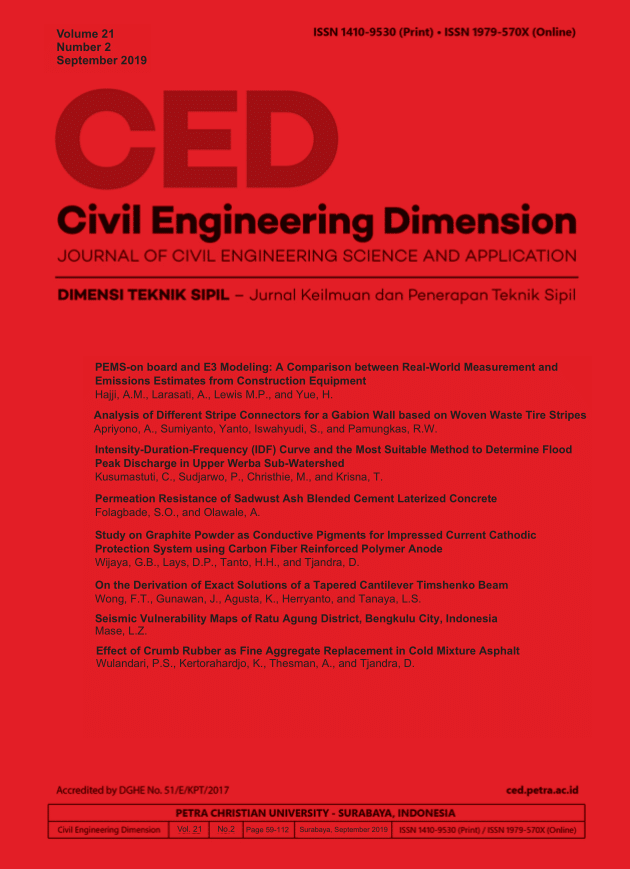On the Derivation of Exact Solutions of a Tapered Cantilever Timoshenko Beam
DOI:
https://doi.org/10.9744/ced.21.2.89-96Keywords:
Timoshenko beam, tapered beam, the principle of minimum potential energy, slender beam, deep beamAbstract
A tapered beam is a beam that has a linearly varying cross section. This paper presents an analytical derivation of the solutions to bending of a symmetric tapered cantilever Timoshenko beam subjected to a bending moment and a concentrated force at the free end and a uniformly-distributed load along the beam. The governing differential equations of the Timoshenko beam of a variable cross section are firstly derived from the principle of minimum potential energy. The differential equations are then solved to obtain the exact deflections and rotations along the beam. Formulas for computing the beam deflections and rotations at the free end are presented. Examples of application are given for the cases of a relatively slender beam and a deep beam. The present solutions can be useful for practical applications as well as for evaluating the accuracy of a numerical method.References
Balduzzi, G., Aminbaghai, M., Sacco, E., Füssl, J., Eberhardsteiner, J., and Auricchio, F., Non-prismatic Beams : A Simple and Effective Timoshenko-like Model, International Journal of Solids and Structures, Elsevier, 90, 2016, pp. 236–250.
Auricchio, F., Balduzzi, G., and Lovadina, C., The Dimensional Reduction Approach for 2D Non-prismatic Beam Modelling : A Solution based on Hellinger–Reissner Principle, International Journal of Solids and Structures, Elsevier, 63, 2015, pp. 264–276.
Fertis, D.G. and Keene, M.E., Elastic and in- elastic Analysis of Nonprismatic Members, Journal of Structural Engineering, ASCE, 116(2), 1990, pp. 475–489.
Romano, F. and Zingone, G., Deflections of Beams with Varying Reactangular Cross Section, Journal of Engineering Mechanics, ASCE, 118(10), 1992, pp. 2128–2134.
Romano, F., Deflections of Timoshenko Beam with Varying Cross-Section, International Journal of Mechanical Sciences, Elsevier, 38(84), 1996, pp. 1017–1035.
Al-Gahtani, H.J. and Khan, M.S., Exact Analysis of Nonprismatic Beams, Journal of Engineering Mechanics, ASCE, 124(11), 1998, pp. 1290–1293.
Boley, B.A., On the Accuracy of the Bernoulli-Euler Theory for Beams of Variable Section, Journal of Applied Mechanics, ASME, 30(3), 1963, pp. 373–378.
Mercuri, V., Balduzzi, G., Asprone, D. and Auricchio, F., 2D Non-prismatic Beam Model for Stiffness Matrix Evaluation, Proceedings of the World Conference on Timber Engineering, Vienna, Austria, August 22-25, 2016.
Bathe, K. J., Finite Element Procedures, Prentice-Hall, New Jersey, 1996.
Cowper, G.R., The Shear Coefficient in Timoshenko’s Beam Theory, Journal of Applied Mechanics, ASME, 33(2), 1966, pp. 335–340.
Hughes, T.J.R., The Finite Element Method: Linear Static and Dynamic Finite Element Analysis, Prentice-Hall, New Jersey,1987.
Garikipati, K., Introduction to Finite Element Methods, Open Michigan, 2013. Available: https://open.umich.edu/find/open-educational-resources/engineering/introduction-finite-element-methods. [Accessed: 23-Jan-2019].
Cook, R.D., Malkus, D.S., Plesha, M.E. and Witt, R.J., Concepts and Applications of Finite Element Analysis, Fourth edition, John Wiley and Sons, New York, 2002.
Ghali, A. and Neville, A., Structural Analysis: A Unified Classical and Matrix Approach, Second edition, Chapman and Hall, London, 1978.
CSI Analysis Reference Manual for SAP2000, ETABS, and SAFE, Computers and Structures Berkeley, California, 1995.
Wong, F.T. and Sugianto, S., Study of the Discrete Shear Gap Technique in Timoshenko Beam Elements, Civil Engineering Dimension, Petra Christian University, 19(1), 2017, pp. 54–62.
Wong, F.T., Sulistio, A., and Syamsoeyadi, H., Kriging-Based Timoshenko Beam Elements with the Discrete Shear Gap Technique, International Journal of Computational Methods, World Scientific, 15(07), 2018, pp. 1850064-1–1850064-27.
Downloads
Published
How to Cite
Issue
Section
License
Authors who publish with this journal agree to the following terms:- Authors retain the copyright and publishing right, and grant the journal right of first publication with the work simultaneously licensed under a Creative Commons Attribution License that allows others to share the work with an acknowledgement of the work's authorship and initial publication in this journal.
- Authors are able to enter into separate, additional contractual arrangements for the non-exclusive distribution of the journal's published version of the work (e.g., post it to an institutional repository or publish it in a book), with an acknowledgement of its initial publication in this journal.
- Authors are permitted and encouraged to post their work online (e.g., in institutional repositories or on their website) followingthe publication of the article, as it can lead to productive exchanges, as well as earlier and greater citation of published work (See The Effect of Open Access).











